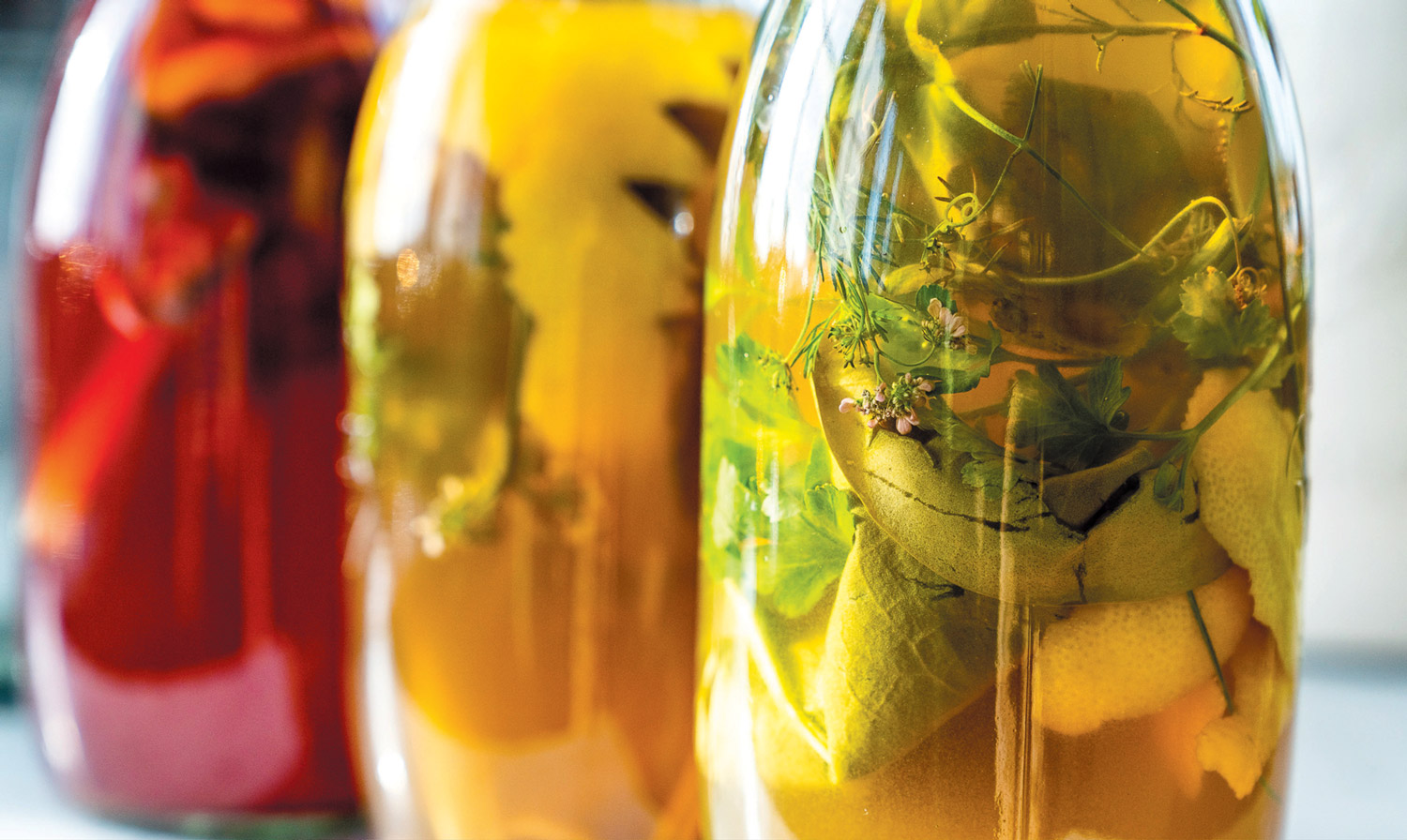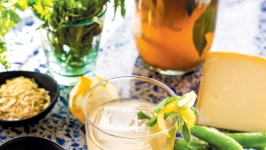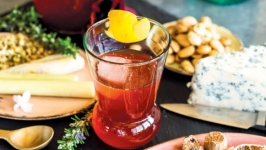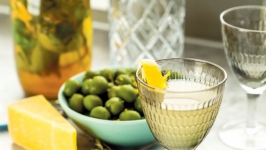Vermouth, The Sipping Spirit
Americans are infamous for preferring bland foods. I confirmed this for myself when I began traveling the globe and tasting a plethora of spicy, bitter and botanical flavors that seemed mainstream in the Middle East, South America, Europe and Africa; basically everywhere except the U.S. Of the five major flavor groups— sweet, salty, sour, bitter and umami—bitter was the one most absent in American cuisines.
I find bitter flavors both enjoyable and interesting; they help balance all the others. I have been pleased to note of late that American palates seem to be shifting, or at least expanding. This is perhaps a by-product of eaters becoming more conscious about what we eat and drink in general, and also a result of more cuisines leaping border walls.
While the craft bitters explosion has been in full swing in the cocktail scene for many years now, bitter foods—think chicory and radicchio, certain citrus fruits like grapefruit and pomelo, and the currently ubiquitous Brussels sprouts—are also rising in popularity. Enter vermouth, a typically bitter sipping spirit, long a staple in certain cultures, enjoyed as a palate opener and “whetter” of appetites before meals.
In ancient times, among those with economic means, “aromatized” wine elixirs, basically what we know today as vermouth, were sipped as a means of achieving and maintaining good health, as well as for pure enjoyment. The ritual drinking of these potions also encouraged a sense of community.
WHAT is Vermouth?
Vermouth is technically aromatized fortified wine. Traditionally, the main “bittering” agent is wormwood, but the U.S. (unlike the E.U.) doesn’t legally require wormwood for a spirit to be classified as vermouth. Both red and white vermouths typically use a neutral white wine base, which is fortified with a distilled spirit and aromatized with a bevy of botanicals, ranging from flowers to bark to spices to herbs— everything from root to seed.
Some version of this elixir has existed for ages. Greeks are known to have added wormwood to wine as far back as 500 BC. Ancient texts note that the Chinese added medicinal botanicals to wine as early as 1000 BC. In Persia (now Iran), records from 5000 BC describe wines infused with resin from a tree related to today’s pistachio.
Modern vermouth emerged later, around the 16th century, in the heart of alpine Italy along the border with France. At that time, the Italians (and the neighboring French) exhibited significant wine production and mastery. Great wealth, botanically rich terrain and access to the world’s best spice routes all led to refinement in the art of crafting vermouth. Commercial production and global distribution came next, around the time the modern cocktail was born. Vermouth quickly became what most Europeans sipped before meals, and elsewhere it was used as a cocktail ingredient—most notably in the Manhattan and martini.
Today we are seeing a rebirth of the art of vermouth-making, and a recent surge in local production seems like an obvious “next step” for Wine Country craftspeople, combining the area’s well-made white wines, bounty of local wild botanicals and artisan-crafted distilled fortifying agents. Smaller production enables greater creativity, it seems, and with this wave of New World vermouth makers there is a trend towards using other bitter roots and barks from the Artemisia plant family—either in addition to, or instead of, wormwood. With names like gentian, mugwort, cinchona bark, licorice root, cascarilla and orris root, cooking up a potion or two of your own is an alchemist’s dream job.
WHY to DIY Vermouth
Making your own is definitely worth the effort. A bit of magical wizardry is required, as well as finding a source for the botanicals. I find vermouth-making to be most powerful in the spring, when barks, seeds, flowers and greens seem to yearn to be plucked. Making your own enables you to achieve just the right balance of bitter and sweet. I most love the tinkering, then being able to bottle and imbibe the embodiment of my own perspective.
HOW to DIY Vermouth
There are a lot of opinions on how to make your own vermouth but, as history shows, there is no right or best way. The key is to follow the base formula: wine, botanicals (bitters) and alcohol. The rest is really a personal journey.
The botanicals may either be soaked, or “macerated,” in the wine and/or the fortifying spirit, or a mixture of the two, for a prolonged period of time—up to four weeks. During this time, the mixture is tasted periodically to determine just the right time to strain out the botanicals. I find it easier to control the flavors of my vermouth using a heat infusion method, which speeds up the flavoring process.
Wine Base
A lot of recipes online advise using cheap wine as a DIY vermouth base, but I believe you should use a wine you would enjoy drinking on its own. We have plenty of great, economical white wines to choose from in our own backyard. Choose one on the dry side (not fruit forward), that has plenty of acidity and minerality and a decent mouthfeel.
Samantha Sheehan of Poe Wines, who, in addition to making great wines, also crafts several vermouths, uses Manchester Ridge Chardonnay from Napa. She explained “The grapes are grown in a cold Mendocino micro-climate, with cold days and cold nights. It has a saline-like minerality due to the coastal influence. It’s round and has great mouthfeel, but is very acidic, which is necessary for a vermouth base. This particular Chardonnay doesn’t have a predominant oak essence, which might overpower your vermouth.... It has a salty, lemony backbone that works perfectly as the base.” Look for a wine with these characteristics when making your own vermouth.
Aromatize
Botanicals—especially wormwood—make vermouth “vermouth.” There are basically four categories of botanicals used: bitters, citrus (fresh and dried), spices and herbs (also fresh and dried). These add the flavor, depth and complexity. I sourced my dried botanicals at FloraLuna Apothecary & Trading Co in Petaluma [MonarchBitters.com]. The fresh ingredients are readily available at your local farmers’ market or grocer, or maybe in your own garden.
Fortify
Unaged brandy is the traditional fortifier in vermouth. The proof of the spirit—high—is the important factor, helping to extract the botanicals’ flavors and preserve the flavors.
Most neutral spirits will work to make vermouth, but in my experience it’s easier to create more depth in your vermouth if you start with a fortifying spirit that already includes botanicals. Oakland Spirits Company’s ultra-creative botanical unaged brandies seem more like gin—sans the juniper—and work particularly well. The distillery’s seasonal offerings recently included a marjoram-flavored brandy, an herb commonly used in vermouth. I also like their Shiso-flavored unaged brandy, which displays a front-and-center grassy tone with fresh spearmint, basil and anise complements.
Sip
Once vermouth is opened and exposed to air, it begins oxidizing and can change flavor in as little as 15 minutes, so it’s best sipped when its fresh. Stored in the refrigerator, though, it should last a month or two. After that, it will begin losing aroma and taste—the high proof alcohol can’t stave that off indefinitely. If it does, don’t toss it—it’s still valuable for use in cooking.
Whether you make your own or purchase a bottle, pour yourself a chilled glass of vibrant vermouth this season, toasting to good health, as well as to pleasure. Add a local cheese, a few olives and friends for the perfect prescription. Happiness is healthy.
Spring-Centric Vermouth Recipes
The recipes on the following pages showcase a few different vermouth-making techniques, and three different styles: a herbaceously bright, citrus-forward vermouth; a fresh and sultry-sweet vermouth rouge; and a very dry, bitters-potent botanical version.
Notes for the alchemist:
• It is essential to “bruise” the fresh herbs before adding them to the steeping jars, causing them to release their oils into the liquid. Do this by crushing them between your fingers, or holding them in one hand and slapping them lightly with the other.
• Many of the botanicals are bulky, so don’t fr et about getting a perfect measurement. You can correct the flavor as the mixture steeps.
• Fresh citrus peels are added only at the end as they amp up the bitter quotient in a hurry, but they should not be omitted as they do brighten the vermouth considerably.
• When a recipe calls for a “sprig” of fresh herbs, this means the top 3- to 4-inch cluster of leaves attached to the stem.








